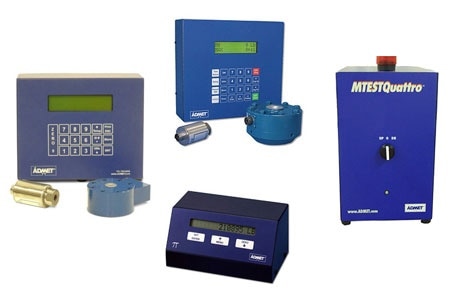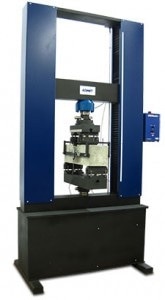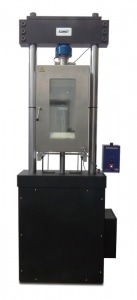Concrete is one of the most commonly used materials on earth. The construction industry is frequently engaged in a broad assembly of testing which necessitates a wide selection of testing equipment.

Image Credit: Panumas Yanuthai/Shutterstock.com
Further to simple compression testing, testing standards such as ASTM C39, ASTM C109, ASTM C469, ASTM C1609 are among the test methods that can be adhered to in order to take measurements of the mechanical properties of a concrete sample. This article explores the mechanical testing of concrete in lab environments, its automation, and the way to achieve it.
Mechanical Testing of Concrete
So that it may be certain that a concrete specimen’s mechanical properties reach the strength and deflection imperatives for its intended use, concrete specimens with specific dimensions are prepared, mold cured and tested adhering to the proper instructions or a standardized test method. As the tests finish, strength reports are generated either manually or by automatic analysis.
Automation in Concrete Testing and Ways of Achieving It
Advantages of concrete testing with automatic control include reduced test times, data entry error removal, and the growing speed in the delivery of results. Automation includes the automatic control of the machine as well as the automatic calculation of the tested properties. When a machine is servo-controlled, it operates through a controller or its software. The test procedure to be run and the analyses to be calculated are inputted into the system and results generate automatically.
A noteworthy point to make here is that particular characteristics of full-automation can become viable through the addition of digital indicators to manually operated systems. Trustworthy indicators developed for the concrete industry can bring together contractor, client, mixture proportion, and field data with the calculated compressive strength data like peak load or the breaking strength with user-chosen parameters which may include date, time, specimen geometry, specimen number and type of break.
Particular indicators also enable concrete testing software to be used. Test results can be moved to a computer running a database program and imported automatically.
Is Manual or Automated Operation More Appropriate for Concrete Testing?
Manually operated systems are frequently enough for concrete testing applications. Nevertheless, particular test standards which govern the concrete industry need strain rate feedback that cannot be attained with manual operation.
For a portion of concrete tests, it is necessary to have verifiable loading rate during all of the testing as concrete displays loading-rate sensitivity relative to compressive strength. Particular ASTM standards, like ASTM C39, specify or cap the loading rate to a specific value or a range in order to make sure of shared consistency in and between laboratories.
When outfitted with the correct digital indicator, the average loading rate can be calculated and reported in accordance with ASTM C39 needs even if the testing was conducted on a manually controlled machine. In addition to other characteristics particularly advantageous for the concrete industry, dependent upon the selected digital indicator, load and stress versus time data and curves can be generated.
For others, such as ASTM C1609, it is a requirement to maintain a low, consistent speed in the duration of the test. Digital indicators do not control the testing machines, so operators are needed to manually adjust a valve to attain the specified rates. Therefore, it is not possible to precisely adhere to standards that need consistent low speed testing with manually operated systems.
Servo-control equipment with controllers that are of use in directing the movement of the machine is endorsed for those types of test. ADMET provides servo-control testing systems built specially for concrete testing as well as closed-loop electromechanical and servo-hydraulic universal testing machines that can be of use in running various material tests.
ADMET Concrete Testing Equipment
ADMET provides a variety of equipment for concrete testing, including indicators to be used with existent manually-controlled systems, controllers to retrofit servo-control machines, the MegaForce Concrete Testing system specially made for the testing of concrete, as well as hydraulic servo-control machines that enable a range of concrete testing to be performed on a single system while producing precise and duplicable results. Additionally, ADMET works to cater to unique consumer needs and has the ability to engineer customized systems.
Digital Indicators for Manually-Operated Testing Systems

Image Credit: Admet Inc.
Pi Indicators
Pi indicators can be connected to both the load cell or the pressure transducer of manually controlled testing machines. The Pi indicator, which is available in three varied models listed below, features a 16-character display, three button keypad and exceeds ASTM E4 force precision needs.
Pi
The Pi model displays the peak load at selectable units of lbf, N, kN, and kgf. ASTM test methods that are capable of running with the Pi model include ASTM C39, C78, and C109.
Pi-R
For concrete testing applications that require testing at verifiable load rates, ADMET’s Pi-R indicator, able to be used with manually-operated machines, displays load rates in addition to the peak load values. Additionally to all the ASTM standards run with the Pi, the Pi-R model also has the capacity for ASTM C293 calculations.
Pi-XS
The Pi-XS presents the peak load, load rate, stress, and the stress rate. It can be of use in calculating ASTM C39, C78, C109, and C293.
Pi-XS can be purchased with its software, GaugeSafe Data Exchange, where users are able to acquire live numerical data and show test results on their PC for further analysis.
DFG Concrete Indicator
The DFG Concrete Indicator was designed especially for applications in concrete testing, with inspiration from ADMET’s now outdated original GaugeBuster indicator. DFG reports the peak load and stress together with the specimen geometry, dimensions, time, date, and specimen number. Further test report parameters frequently wished for by testing labs include the average rate of loading and the cylinder correction factor that are calculated automatically, the operator ID, specimen weight and age, inputted by the operator, and the cylinder break type and cap type. The DFG is supplied with defined specimen geometries which are necessary in the calculation of the stress values such as cylinder, cube, beam center point loading, beam-3rd point loading, round and cross-sectional area.
ADMET’s GaugeSafe Data Exchange software is ready for DFG indicators to enable more analysis and generation of test reports.
GaugeBuster 2
GaugeBuster 2 is an adaptable indicator that is available in a variety of sizes (compact, standard, portable) and enables more attributes and channels to be added. The main advantage of the GaugeBuster 2 for concrete testing is that it has the optional auxiliary (encoder) and strain (analog) channels that enable additional testing, such as ASTM C469, to be conducted.
ADMET provides the compressometer-transducer assembly for ASTM C469, Poisson’s ratio, and Young’s Modulus testing. Once a manually-operated machine is outfitted with the GaugeBuster 2 indicator bought with the optional channels and the C469 assembly, axial and transverse strain can be calculated per ASTM C469.
It is possible to upgrade GaugeBuster 2 Basic with printer capabilities or the USB flash drive port. The Printer Port option enables the GaugeBuster 2 to be connected directly to a printer in order to print data and results whereas the USB Flash Drive Port option enables test results, XY data, test settings, and calibration tables to be saved directly to a flash drive. These choices are particularly of use if it is not possible to access a computer next to the indicator at all times.
All GaugeBuster 2 models can be outfitted with the GaugeSafe Basic, Plus, or Live software. GaugeSafe Basic supplies numerical test results, while GaugeSafe Plus offers numerical values as well as graphs. GaugeSafe Live supplies live test data as well as live graphs within the duration of all of the testing. Since not every user has identical software feature requirements, ADMET provides the option to make selections from the software package that suits their requirements best.
MegaForce Concrete Testing System
The MegaForce Testing System was designed in order to tackle the problems with manually-operated concrete systems and the expenses associated with typical servo-hydraulic testing systems developed with big and costly actuators. By substituting the manual controls on operational testing frames with the MegaForce Testing System, automatic control and operation in load, position, or strain control are allowed ensuring it is possible to run tests like ASTM C1609 or EN 14651.
The MegaForce Concrete Testing System operates with compression machines that operate up to 69 MPa or 10,000psi. Dependent upon the indicator selected with the system, automated compressive strength test reports are created, which save time as well as the expense needed to manually generate reports while reducing the risk of errors.
Universal Testing Systems
Conducting more complex calculations frequently necessitates more data analysis capabilities, more control, and the ability to run tests in the tensile direction or in a broad range of load capacities. ADMET’s adaptable universal testing machines supply a great deal of benefits as an all-in-one solution for any type of concrete testing including tension, compression, and flexion with automated control and strain-rate feedback. A portion of the tests that can be categorized in this way includes ASTM C307, ASTM C469, ASTM C1609, and EN 14651.
Electromechanical Testing Systems
eXpert 2600 electromechanical testing systems are on offer in table top or floor standing configurations and can go up to 400kN (90,000lbf) force capacity. The servo-control motor enables running tests at extremely slow net deflection rates. As a result, greater capacity eXpert 2600 models outfitted with MTESTQuattro software are frequently of use in running complicated testing standards like ASTM C1609.

Image Credit: Admet Inc.
Servo-Hydraulic Testing Systems
eXpert 1600 servo-hydraulic testing systems, with the capability to measure up to 600 kN (135,000 lbf), are developed to conduct compression, tension, and flexion testing. These testing systems can be equipped with various additions including simple compression platens or spherically seated compression platens, the ASTM C469 compressometer-transducer assembly, ASTM C1609 bend fixture assembly with two transducer installed, as well as the EN 14651 bend fixture with one transducer mounted mid-point on the fixture.
An automatic, adaptable machine like ADMET’s eXpert 1657 Servo Hydraulic Test Systems can be extremely advantageous and cost-efficient for industries like oil and gas which conduct mining or downhole cementing activities where a broad range of precision tests may be needed in flexion, compression, and possibly tension.

Image Credit: Admet Inc.
Conclusion
ADMET’s trustworthy testing system, cost vs. performance, and simplicity to use put together with their on-hand customer support means ADMET is a valuable partner in all testing efforts.